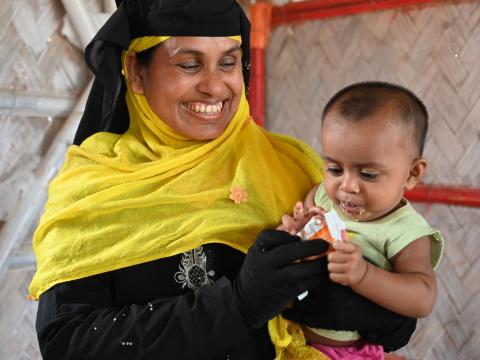Beating malnutrition in the Rohingya camps

Six-month-old Ankis sits on her mother’s lap, sucking on her fingers, her bright eyes inquisitive. Looking at her plump, round face, it’s hard to believe that just over a month ago this little girl was assessed as having acute moderate malnutrition.
Ankis is one of 16,300 Rohingya children under age 5 who are receiving life-saving supplementary food through World Vision’s malnutrition prevention and treatment programme. More than 4,000 pregnant and lactating women, including Ankis’s mother, Sowkat, are also benefitting from the year-long programme.
An estimated 860,000 Rohingya refugees reside here in the world’s largest refugee camp. Extreme violence and decades of human rights abuses in Myanmar forced them to flee their homes in August 2017. Children constitute almost half (51%) of the refugee population; of those 18% are under age 5.
A government study conducted soon after the influx revealed that 13% of children in the camps have moderate acute malnutrition.
That means more than 208,000 children age 0-59 months need life-saving nutrition interventions. Child malnutrition is the single biggest contributor to deaths in children under age 5, making them more susceptible to disease and slow to recover from common illnesses.
To address this critical problem, this year World Vision opened malnutrition prevention and treatment centres in five refugee camps to reach 16,303 at-risk children, building on previous successful programmes.
At the World Vision centres, which are operated in partnership with the World Food Programme and UNICEF, children are weighed, measured and their nutritional status assessed.
To help prevent malnutrition, World Vision supplies all 16,300 children under age five in the five camps with monthly rations of Super Cereal. This blend of corn, soybeans, milk powder, sugar, soybean oil is packed with vitamins and complements breastfeeding. Through the Super Cereal, children receive the nutrients they need to stay healthy—Vitamin A, D3, E, K, B1, B2, B6, B12, C, Calcium, Folic acid, Niacin, Biotin, Iodine, Iron, and Zinc.
Children who are underweight for their height, and who are assessed as suffering from moderate acute malnutrition, receive the Super Cereal, as well as PlumpySup—a ready-to-use, high-energy food supplement. It comes in packets, is easy for a child to eat and can be stored without refrigeration. World Vision monitors the malnourished children taking PlumpySup every 14 days until they reach their normal weight-for-height.
World Vision staff members teach mothers how to properly prepare the Super Cereal and to use the PlumpySup. Mothers who are pregnant or lactating also receive a ration of food to boost their nutrition while they breastfeed.
Since the programme began in January 2020, 501 children assessed as having severe acute malnutrition (SAM) have been closely monitored by World Vision’s nutrition team. To date, 227 of the children have reached their normal weight-for-height; the remainder is continuing to steadily progress.
Today, Sowkat and Ankis are among 10 mothers and their children waiting for their regular check-up at World Vision’s nutrition centre in Camp 25. On average, 120 mothers and children visit the centre each day to monitor to be monitored and receive supplementary food.
Ankis’s mother, Sowkat, 30, first came to World Vision’s centre when she was pregnant. “I have been receiving services from World Vision’s nutrition centre for the last 11 months,” says Sowkat, who has five children, including Ankis. “During my pregnancy, I attended counselling sessions here. Staff members advised me to eat nutritious foods, such as colourful vegetables, fish, meat and fruit. They also demonstrated how to prepare food.”
Ankis was registered at the centre on 4 June 2020 when she was just five months old.
“We found that Ankis had moderate acute malnutrition. Her mother couldn’t breastfeed her because she was ill,” says Mohammad Hamid Al Muktadir, supervisor of the centre.
Ankis was given supplementary Super Cereal and PlumpySup to help her gain weight, and her health is monitored monthly at the centre.
“Ankis receives 28 small packets of PlumpySup every month. We give her one-pack each day. She really likes it,” laughs Sowkat, as Ankis licks the PlumpySup wrapper hungrily. “In just one month, I already see an improvement. She looks healthier. I am happy to see my daughter looking happy.”
Sowkat is hopeful about her daughter’s future. “We were given shelter here in Bangladesh. If agencies like World Vision had not come forward to save our children’s lives, we would have been crying in the wilderness, watching their sufferings,” she says. “The support we have received is an endless blessing for us and our children.”
Ankis is steadily recovering, growing stronger each day. But now Sowkat has a new concern: COVID-19. As of 28 June, 50 Rohingya refugees had tested positive for COVID-19. Although the number of cases seems relatively low given the size of the camp population, the risk of infection is high in this sprawling makeshift megacity of 860,000 people. Social distancing here is difficult given the camps’ population density of 40,000 people per square km.
Sowkat is also grateful that she has learned how to protect herself and Ankis from COVID-19. “Staff at the centre told us how to protect ourselves from the danger of COVID-19,” she says. “We learned about washing our hands with soap frequently for 20 seconds every time, and that we should also maintain social distancing.”
Story: Xavier Sku/World Vision